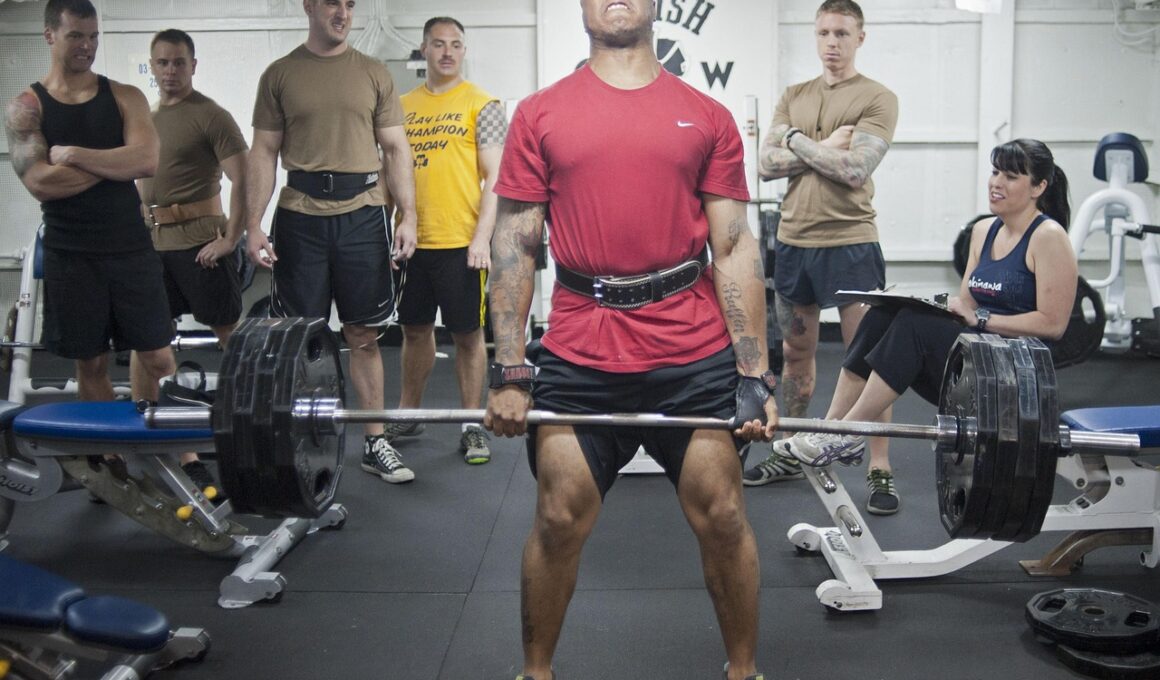How to Use Deadlifts for Fat Loss and Muscle Building
Deadlifts are a powerful exercise that targets multiple muscle groups effectively, making them exceptional for fat loss and muscle building. When variety is added to your workout routine, results will be amplified. To get started, focus on the proper form to prevent injuries and maximize effectiveness. Start with your feet hip-width apart, grip the barbell just outside your knees, and keep your back straight. Utilize your legs and hips to lift the barbell off the ground while keeping your core engaged. Progressively add weight as your strength improves while maintaining correct form. Ensure you breathe correctly during the exercise; exhale as you lift and inhale while lowering. Many benefits accompany deadlifts, such as improved core strength, better posture, and increased metabolic rate. These factors contribute significantly to body composition improvement and overall fitness enhancement. Incorporate deadlifts into your workouts at least once a week, combining them with compound movements like squats and bench presses to enhance overall results. Keep in mind that proper nutrition and rest are equally essential components for achieving your fitness goals when using deadlifts.
Understanding Exercise Variations
There are various deadlift variations that can align with your specific fitness goals, each emphasizing different muscle groups and providing unique benefits. The traditional deadlift is fantastic for total body engagement, while the sumo deadlift shifts the emphasis more towards the inner thighs and glutes. In contrast, the Romanian deadlift targets the hamstrings and lower back, making it a great option for muscle building. Moreover, the single-leg deadlift improves balance and stability while effectively working the hamstrings and glutes. You can also engage in variations like the trap bar deadlift which places less strain on the lower back and can improve lifting mechanics. When selecting a variation, consider your personal fitness levels and goals to determine the deadlift style that suits you best. Utilizing these variations keeps training exciting and encourages consistent progression, while also preventing plateaus in muscle growth or fat loss. Incorporate these variations into your routine to continually challenge your body and enhance your results. Pair these variations with a well-structured workout plan to optimize your exercise effectiveness and overall success.
Incorporating deadlifts into a well-rounded program requires attention to recovery and nutrition practices to nurture muscle growth while facilitating fat loss. One critical component is timing your nutrition around your workout sessions. Aim to consume a balanced meal rich in protein and complex carbohydrates about an hour before exercising. Post-workout, refuel through a protein-rich snack to promote muscle repair and growth. Several studies emphasize the role of a high-protein diet paired with resistance training in improving body composition. In addition, sufficient hydration should not be overlooked, as water plays a significant role in performance and recovery. Remember that inadequate hydration may lead to fatigue and decreased strength, impeding your efforts in the gym. Developing a personalized recovery plan that prioritizes sleep, hydration, and nutrition will prove invaluable for maximizing the benefit of deadlifts. Consider active recovery strategies like light cardio and stretching to alleviate muscle soreness. This approach can positively impact your overall results while fostering a sustainable workout routine. Being attentive to these factors will ensure that your journey toward fat loss and muscle building remains enjoyable and effective.
It is essential to track your progress when incorporating deadlifts into your routine. Regular monitoring allows you to adjust your workout for optimal results and motivates you to stay committed. Consider keeping a workout journal or utilizing a mobile application to record your lifting weights, repetitions, and overall performance metrics. Performing weekly assessments will help you identify areas that require improvement or additional focus. When you’re aware of your progress, it’s easier to set achievable goals, including increasing weight or refining technique. Establish short-term and long-term goals that fit within a structured training program. Celebrate small victories along the way, as this positive reinforcement helps maintain enthusiasm and commitment amidst challenges. You could set milestones like adding ten pounds to your deadlift every month or mastering a new deadlift variation each month to keep things exciting. Consistency plays a crucial role in achieving successful outcomes; keep pushing through temporary setbacks. Engage with a workout buddy or personal trainer for additional motivation and accountability, further enhancing your chances of success in fat loss and muscle building through deadlifts.
Integrating Deadlifts with Other Exercises
The deadlift can be seamlessly integrated into broader workout programs that cover overall strength and endurance. Pairing deadlifts with complementary exercises enhances both fat loss and muscle building efforts. Begin with compound lifts like squats and overhead presses to build foundational strength. Follow your deadlifts with bent-over rows or pull-ups, both designed to strengthen the upper body and back muscles while forcing calorie expenditure. A balanced routine should include varied rep ranges to spark muscle growth and endurance, meaning mixing low-rep heavy lifting sessions with higher-rep circuits. This combination allows you to achieve optimal muscle stimulation necessary for growth while also enhancing your metabolic rate. Don’t hesitate to alter your rep schemes as you progress to keep your muscles guessing. Moreover, implement active recovery days—these can incorporate lighter weights or bodyweight exercises to ensure ongoing movement without overtaxing your muscles. Developing a well-structured training split with deadlifts as a cornerstone will put you on track towards reaching your fitness goals, drastically changing your body composition in the long run.
To further optimize your fat loss and muscle-building results, consider including mobility and flexibility training alongside your deadlift routine. Flexibility can enhance your range of motion during deadlifts, resulting in better performance and fewer injuries. Incorporate dynamic stretches before your workout to warm up your muscles, along with static stretches after your workout to aid recovery—this practice will keep your muscles pliable and aid recovery. Yoga and Pilates can complement your deadlifts very effectively, focusing on core strength and flexibility, which improves overall lifting mechanics. Improving your core stability enhances your ability to lift heavier weights and increases your body’s efficiency during deadlifts. Focus on incorporating flexibility training into your fitness routine at least two to three times per week for optimal results. Here, balancing strength training and mobility work will contribute to a well-rounded fitness regimen. This approach enables firing multiple muscle groups simultaneously while improving overall functional ability and injury prevention, further boosting muscle building and fat loss outcomes over time.
Finally, always prioritize safety and proper technique when implementing deadlifts into your workout. Engaging in exercises without understanding proper form can lead to injuries and setbacks, undermining your fitness efforts. Before performing deadlifts, practice basic movement patterns using a lightweight or no weight at all. Ensure your head is in a neutral position while your back remains straight, avoiding rounded shoulders that can lead to injuries. If possible, seek guidance from experienced trainers who can observe your form and provide corrective feedback. Regularly reassess your technique as you progress with your strength to ensure safety and effectiveness remain consistent. Listen to your body and allow sufficient recovery time if you experience discomfort or pain. It’s crucial to approach deadlifts with a long-term mindset for sustainable results. Always aim to promote health and fitness through safe practices as you work towards your fat loss and muscle-building goals. By following these strategies, you will create a stronger, sustainable foundation in your workout journey through dedicated work using deadlifts.
Conclusion: Embrace Deadlifts!
Deadlifts are a multifunctional exercise that can significantly contribute to fat loss and muscle building. By incorporating correct techniques and variations, tracking your progress, and prioritizing recovery, you enhance your chances of significant improvements in body composition. Embrace the versatility that deadlifts offer to maximize training outcomes while enjoying the process. Remember to focus on proper form and integration with complementary exercises to create a balanced workout regimen. With dedication and consistency, deadlifts can become a valuable part of your fitness journey; they promote strength, efficiency, and a healthier lifestyle. As you implement these strategies, maintain an optimistic attitude, knowing that every effort you invest leads you closer to your fitness goals. Fit deadlifts into your weekly routine, and you will soon appreciate their transformative power in enhancing overall athletic performance while sculpting your physique. Commit to your health today, and make deadlifts a priority in your training regimen. The potential for bodily change and improved performance lies within your determination to refine your approach, ensuring the achievement of your fitness aspirations.


